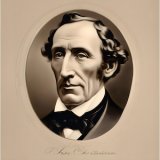Beauty of Form and Beauty of Mind
"Beauty of Form and Beauty of Mind" is a thought-provoking tale by celebrated Danish author Hans Christian Andersen. It explores the comparison and contrast of physical beauty and inner beauty, emphasising the importance of the latter. The story centers around a beautiful narcissistic prince and a sweet-spirited but average-looking poet and their experiences with love and empathy. Andersen delicately portrays how outer beauty can be deceiving, and how meaningful conversations and a pure heart possess a beauty of their own.
There was once a sculptor, named Alfred, who having won the large gold medal and obtained a travelling scholarship, went to Italy, and then came back to his native land. He was young at that time--indeed, he is young still, although he is ten years older than he was then. On his return, he went to visit one of the little towns in the island of Zealand. The whole town knew who the stranger was; and one of the richest men in the place gave a party in his honor, and all who were of any consequence, or who possessed some property, were invited. It was quite an event, and all the town knew of it, so that it was not necessary to announce it by beat of drum. Apprentice-boys, children of the poor, and even the poor people themselves, stood before the house, watching the lighted windows; and the watchman might easily fancy he was giving a party also, there were so many people in the streets. There was quite an air of festivity about it, and the house was full of it; for Mr. Alfred, the sculptor, was there. He talked and told anecdotes, and every one listened to him with pleasure, not unmingled with awe; but none felt so much respect for him as did the elderly widow of a naval officer. She seemed, so far as Mr. Alfred was concerned, to be like a piece of fresh blotting-paper that absorbed all he said and asked for more. She was very appreciative, and incredibly ignorant--a kind of female Gaspar Hauser. "I should like to see Rome," she said; "it must be a lovely city, or so many foreigners would not be constantly arriving there. Now, do give me a description of Rome. How does the city look when you enter in at the gate?" "I cannot very well describe it," said the sculptor; "but you enter on a large open space, in the centre of which stands an obelisk, which is a thousand years old." "An organist!" exclaimed the lady, who had never heard the word 'obelisk.' Several of the guests could scarcely forbear laughing, and the sculptor would have had some difficulty in keeping his countenance, but the smile on his lips faded away; for he caught sight of a pair of dark-blue eyes close by the side of the inquisitive lady. They belonged to her daughter; and surely no one who had such a daughter could be silly. The mother was like a fountain of questions; and the daughter, who listened but never spoke, might have passed for the beautiful maid of the fountain. How charming she was! She was a study for the sculptor to contemplate, but not to converse with; for she did not speak, or, at least, very seldom. "Has the pope a great family?" inquired the lady. The young man answered considerately, as if the question had been a different one, "No; he does not come from a great family." "That is not what I asked," persisted the widow; "I mean, has he a wife and children?" "The pope is not allowed to marry," replied the gentleman. "I don't like that," was the lady's remark. She certainly might have asked more sensible questions; but if she had not been allowed to say just what she liked, would her daughter have been there, leaning so gracefully on her shoulder, and looking straight before her, with a smile that was almost mournful on her face? Mr. Alfred again spoke of Italy, and of the glorious colors in Italian scenery; the purple hills, the deep blue of the Mediterranean, the azure of southern skies, whose brightness and glory could only be surpassed in the north by the deep-blue eyes of a maiden; and he said this with a peculiar intonation; but she who should have understood his meaning looked quite unconscious of it, which also was charming. "Beautiful Italy!" sighed some of the guests. "Oh, to travel there!" exclaimed others. "Charming! Charming!" echoed from every voice. "I may perhaps win a hundred thousand dollars in the lottery," said the naval officer's widow; "and if I do, we will travel--I and my daughter; and you, Mr. Alfred, must be our guide. We can all three travel together, with one or two more of our good friends." And she nodded in such a friendly way at the company, that each imagined himself to be the favored person who was to accompany them to Italy. "Yes, we must go," she continued; "but not to those parts where there are robbers. We will keep to Rome. In the public roads one is always safe." The daughter sighed very gently; and how much there may be in a sigh, or attributed to it! The young man attributed a great deal of meaning to this sigh. Those deep-blue eyes, which had been lit up this evening in honor of him, must conceal treasures, treasures of heart and mind, richer than all the glories of Rome; and so when he left the party that night, he had lost it completely to the young lady. The house of the naval officer's widow was the one most constantly visited by Mr. Alfred, the sculptor. It was soon understood that his visits were not intended for that lady, though they were the persons who kept up the conversation. He came for the sake of the daughter. They called her Kaela. Her name was really Karen Malena, and these two names had been contracted into the one name Kaela. She was really beautiful; but some said she was rather dull, and slept late of a morning. "She has been accustomed to that," her mother said. "She is a beauty, and they are always easily tired. She does sleep rather late; but that makes her eyes so clear." What power seemed to lie in the depths of those dark eyes! The young man felt the truth of the proverb, "Still waters run deep:" and his heart had sunk into their depths. He often talked of his adventures, and the mamma was as simple and eager in her questions as on the first evening they met. It was a pleasure to hear Alfred describe anything. He showed them colored plates of Naples, and spoke of excursions to Mount Vesuvius, and the eruptions of fire from it. The naval officer's widow had never heard of them before. "Good heavens!" she exclaimed. "So that is a burning mountain; but is it not very dangerous to the people who live near it?" "Whole cities have been destroyed," he replied; "for instance, Herculaneum and Pompeii." "Oh, the poor people! And you saw all that with your own eyes?" "No; I did not see any of the eruptions which are represented in those pictures; but I will show you a sketch of my own, which represents an eruption I once saw." He placed a pencil sketch on the table; and mamma, who had been over-powered with the appearance of the colored plates, threw a glance at the pale drawing and cried in astonishment, "What, did you see it throw up white fire?" For a moment, Alfred's respect for Kaela's mamma underwent a sudden shock, and lessened considerably; but, dazzled by the light which surrounded Kaela, he soon found it quite natural that the old lady should have no eye for color. After all, it was of very little consequence; for Kaela's mamma had the best of all possessions; namely, Kaela herself. Alfred and Kaela were betrothed, which was a very natural result; and the betrothal was announced in the newspaper of the little
Translation
Translate and read this book in other languages:
Select another language:
- - Select -
- 简体中文 (Chinese - Simplified)
- 繁體中文 (Chinese - Traditional)
- Español (Spanish)
- Esperanto (Esperanto)
- 日本語 (Japanese)
- Português (Portuguese)
- Deutsch (German)
- العربية (Arabic)
- Français (French)
- Русский (Russian)
- ಕನ್ನಡ (Kannada)
- 한국어 (Korean)
- עברית (Hebrew)
- Gaeilge (Irish)
- Українська (Ukrainian)
- اردو (Urdu)
- Magyar (Hungarian)
- मानक हिन्दी (Hindi)
- Indonesia (Indonesian)
- Italiano (Italian)
- தமிழ் (Tamil)
- Türkçe (Turkish)
- తెలుగు (Telugu)
- ภาษาไทย (Thai)
- Tiếng Việt (Vietnamese)
- Čeština (Czech)
- Polski (Polish)
- Bahasa Indonesia (Indonesian)
- Românește (Romanian)
- Nederlands (Dutch)
- Ελληνικά (Greek)
- Latinum (Latin)
- Svenska (Swedish)
- Dansk (Danish)
- Suomi (Finnish)
- فارسی (Persian)
- ייִדיש (Yiddish)
- հայերեն (Armenian)
- Norsk (Norwegian)
- English (English)
Citation
Use the citation below to add this book to your bibliography:
Style:MLAChicagoAPA
"Beauty of Form and Beauty of Mind Books." Literature.com. STANDS4 LLC, 2025. Web. 22 Feb. 2025. <https://www.literature.com/book/beauty_of_form_and_beauty_of_mind_2141>.








Discuss this Beauty of Form and Beauty of Mind book with the community:
Report Comment
We're doing our best to make sure our content is useful, accurate and safe.
If by any chance you spot an inappropriate comment while navigating through our website please use this form to let us know, and we'll take care of it shortly.
Attachment
You need to be logged in to favorite.
Log In